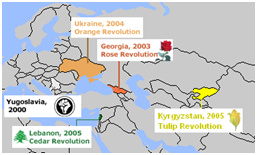What are colour revolutions?
Context: A “colour revolution” is in reference to protests that have toppled unpopular regimes. They have occurred most often in the former Soviet Union and the Middle East. However, these series of colored uprisings were first seen in communications in eastern Europe in the early 2000s.
- Velvet Revolution:
- In 1989, the police of Czechoslovakia attacked a peaceful demonstration led by students which was intended to commemorate the 50th anniversary of the suppression of a student demonstration in German-occupied Prague.
- The communist authorities were forced to negotiate with the opposition. As a result, a transition government incorporating members of the Civic Forum and Public Against Violence was formed, and Gustav Husak resigned. Havel was elected to the post of interim president and he was reelected to the presidency in July 1990, becoming the country’s first non-communist leader.
- Orange Revolution:
- The Orange Revolution refers to the protests that occurred in Ukraine in response to reports from international and domestic observers that claimed that the country’s 2004 Presidential election was rigged.
- Tulip Revolution:
- The colored revolution which took place in Kyrgyzstan was the Tulip Revolution. The protests were in response to the parliamentary elections in which President Askar Akayev’s allies and family won. Immediately, protests erupted against Akayev who had been President since 1990. Ultimately, he resigned.
- Jasmine Revolution:
- The Jasmine Revolution occurred in Tunisia in response to the underlying corruption, unemployment, inflation and lack of political freedom in the country. .
- Lotus Revolution
- This revolution took place in Egypt as a response against the increasing police brutality. Under the Hosni Mubarak government, which finally led to Hosni Mubarak stepping down and handing over the powers to the army.
| Practice Question
1. What do you understand about the colour revolution? Give a few examples of it?
|




